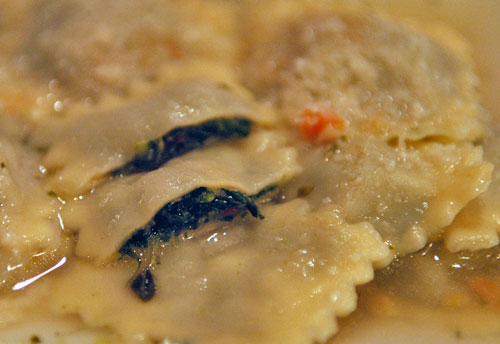We’ve recently finished reading Bill Buford’s book, Heat. He tells the tales of a mid-life career change from editor to cook and everything along the way - including learning Italian and several long trips to Italy to learn to cook. One of his tutors is a 16th century Italian named Bartolomeo Scappi, who wrote a Renaissance cookbook called Opera dell’arte del cucinare.
Buford mentions in passing Scappi’s mixture of beets and spinach as a tortellini filling and this intrigued me. Beets (yum!) and spinach (yum!) together? Wow. I wanted to try it. So I found a reference to Scappi’s recipe. It wasn’t beetroot, as I’d assumed, but beet tops, also known as chard. Still, it looked to be a delicious recipe with a surprising twist of cloves and cinnamon, so we tried it.

Scappi’s beet and spinach ravioli
Here’s Scappi’s recipe (translated by Helewyse de Birkestad with my notes in []):
Per far minestra di tortelletti d’herba alla Lombarda Cap CLXXIX Piglinosi biete, e spinaci, taglianosi minute, & lavinsoi in piu acque, e strucchisi fuori l’acqua, faccianosi soffriggere con butiro fresco, & con esse ponasi a bollire una brancata d’herve odorifere, & cavinosi, & pongasi in un vaso di terra o di rame stagnato, & giungavisi cascio Parmeggiano grattato, & cascio grasso, tanto dell’uno quanto dell altro, & pepe, cannella, garofani, zafferano, uva passa, & uove crude a bastanza; & se la compositione fosse troppo liquida pongavisi pan grattato, ma se sarà troppo soda, mettavisi un poco di butiro, & habbiasi un sfoglio di pasta fatta nel modo che si dice nel capitolo 177. & faccianosi i tortelletti piccioli, & grandi, facendoli cuorcere in buon brodo di carne, & servanosi con cascio, zuccaro, & cannella sopra.To make a dish of tortellini of herbs in the Lombard style, Chapter 179
Take beet (beet tops or swiss chard), and spinach [1 bunch each], chop very finely, and wash in more water and then drain out all the water. Put the greens to fry in fresh butter and with them add to boil a hand full of odoriferous herbs [we used parsley, chervil and oregano]. Take them out and put them (herbs and greens) into a jar of pottery or of tinned copper, and add grated Parmesan cheese and fat cheese [no fat cheese for us], more of the one than of the other. Also add pepper [1/2 tsp], cinnamon, cloves [dash of each], saffron [5 stamens softened in 1/2 tsp water], dried currants [we used about 10 raisins cut in half] and enough raw eggs [1/2 an egg, beaten]. If the mixture becomes too soft and bread crumbs, but if it is too hard, add a little butter. Have a sheet of pasta made in the way that is described in chapter 177. And make small and large tortelletti, and cook them in good meat broth, and serve them with cheese, sugar and cinnamon on top.
We made a few substitutions from the original recipe. Chard is not available in Japan, so we used a Chinese vegetable called ta-sai, which is related to mustard and broccoli. We made ravioli rather than tortellini, and we boiled our ravioli in vegetable broth instead of meat broth. With those substitutions in place, we found the recipe wanted no other changes. It was outstanding.
I’m looking forward to tracking down some other Scappi recipes and trying them.
Still, I want to try beets and spinach together. I think it would be interesting. Experimentation in the new year, I think!
Listening to Tom Allen on CBC’s Music and Company this morning I learned that beets, in the sixteenth century, were not the orotund perfections they are today after centuries of inbreeding. Rather they were more carot like, as in long and sylph like. Also they were not a robust burgandy red but orangey-yellow and sometimes bluish. These progenitor forms are currently returning as the latest new thing. So your recipe might be even more different then you think! Many thanks for this, my Karisumas’ gift.
Thank you for blogging and I wish you and Tad Omeditoo Gozaiimashita!
—ml
I’m so glad you had fun making these. Your choice of another dark green (instead of chard) was appropriate. There are many recipes in Scappi which call for “greens and herbs” rather than specific named vegetables. The knowledge that the bietola called for in his recipes is beet greens as opposed to roots is that roots just don’t seem to show up until later. Although I have found an early 17th century recipe for beet salad in another book.
Scappi was a fantastic cook and his book has more wonderful recipes than you can believe (over 1000). Time moves on and I continue to translate recipes and post them on my website. http://www.geocities.com/helewyse Have fun, try something else. I’d love to see the results.
Louise (Helewyse de Birkestad)
